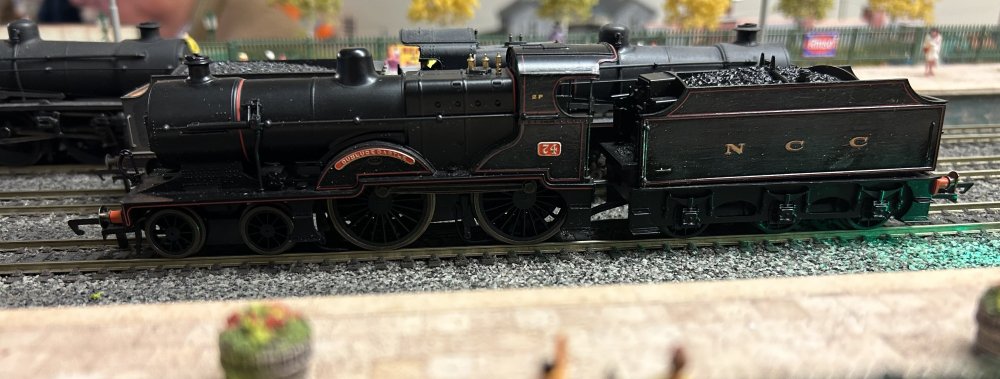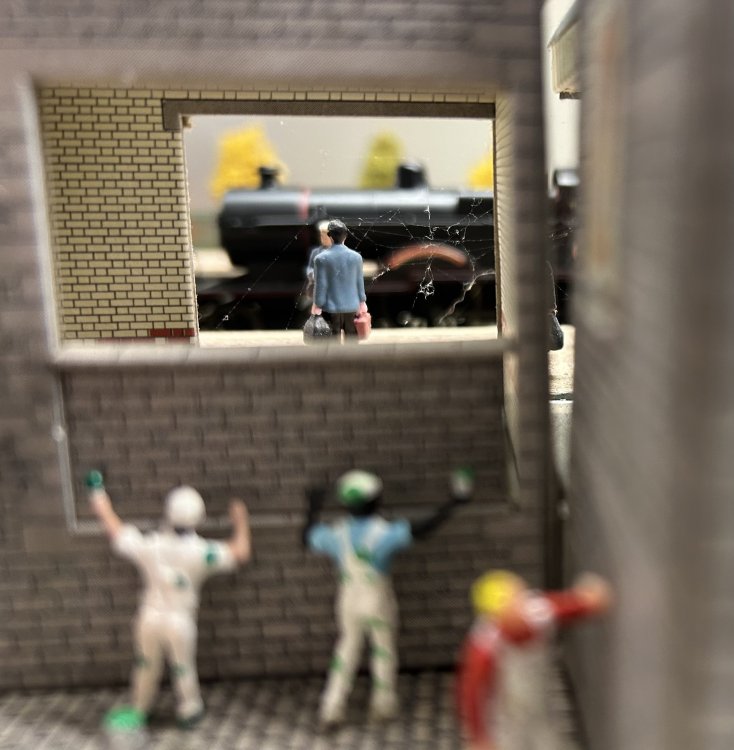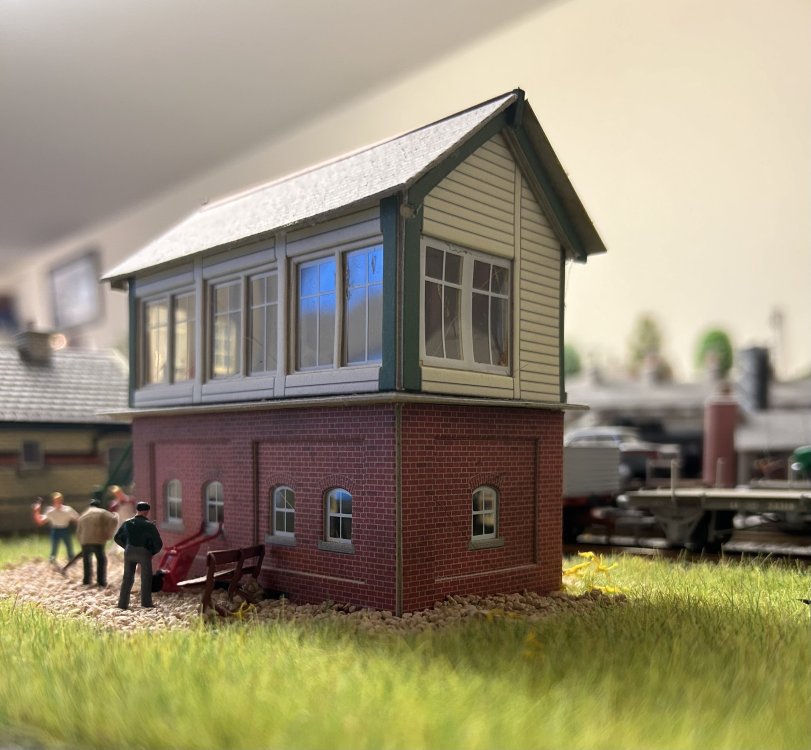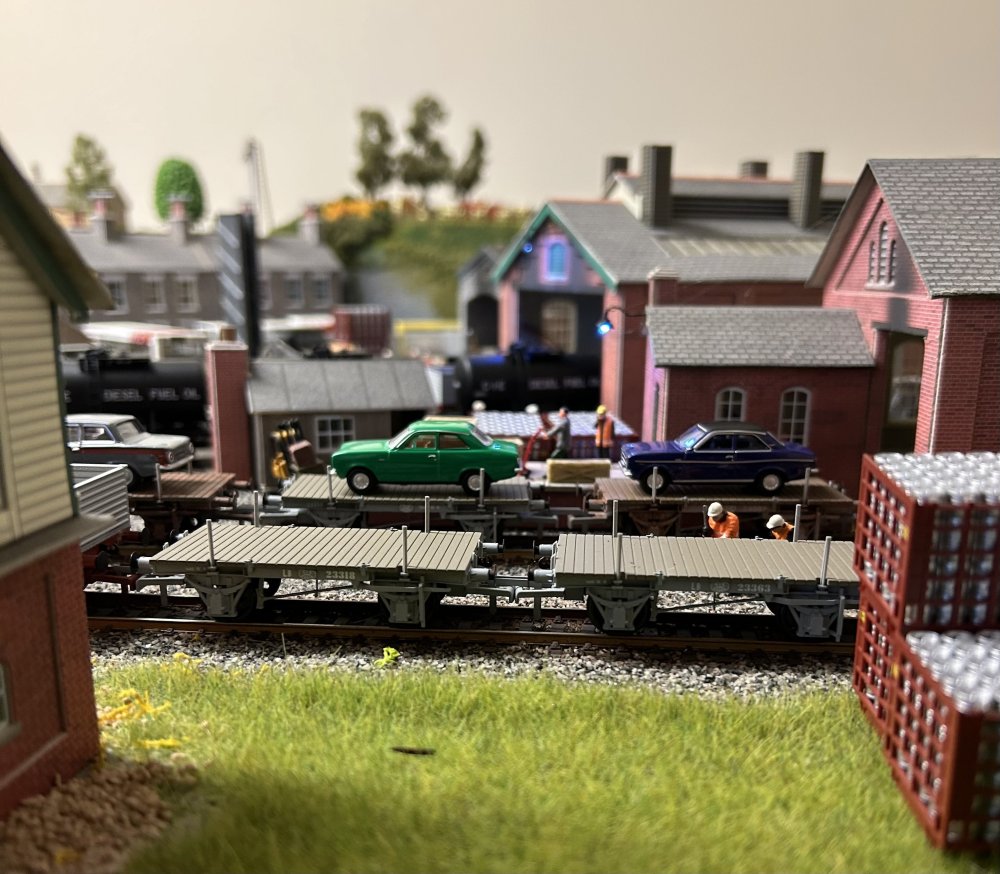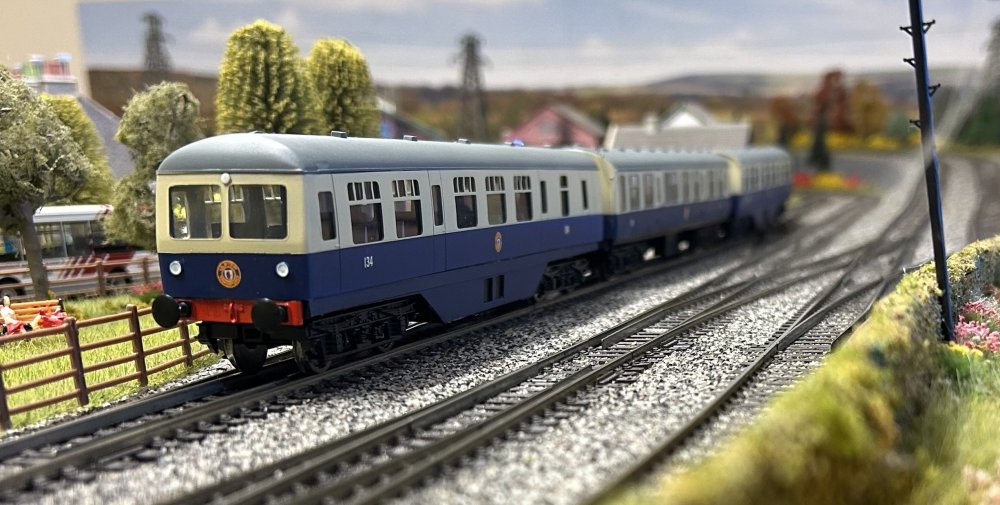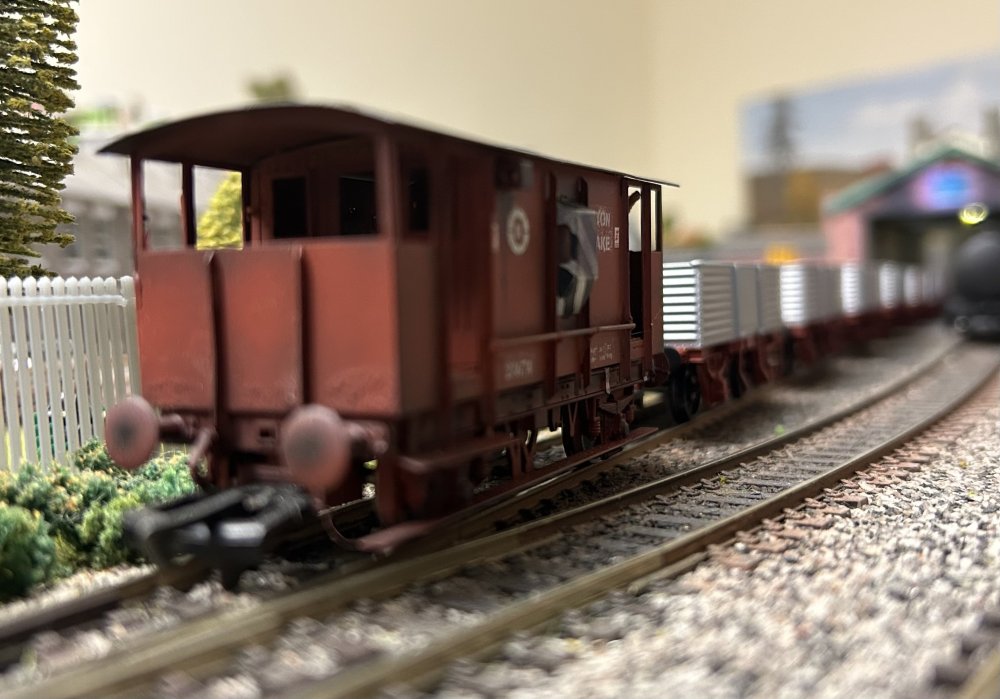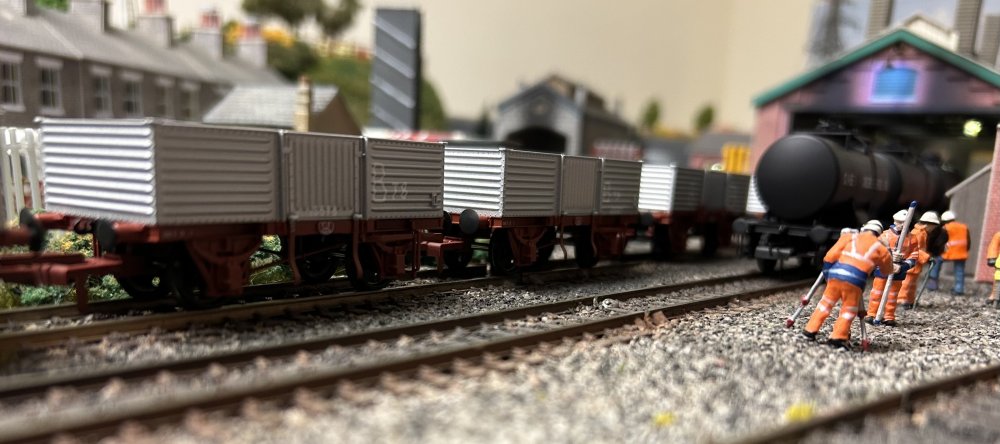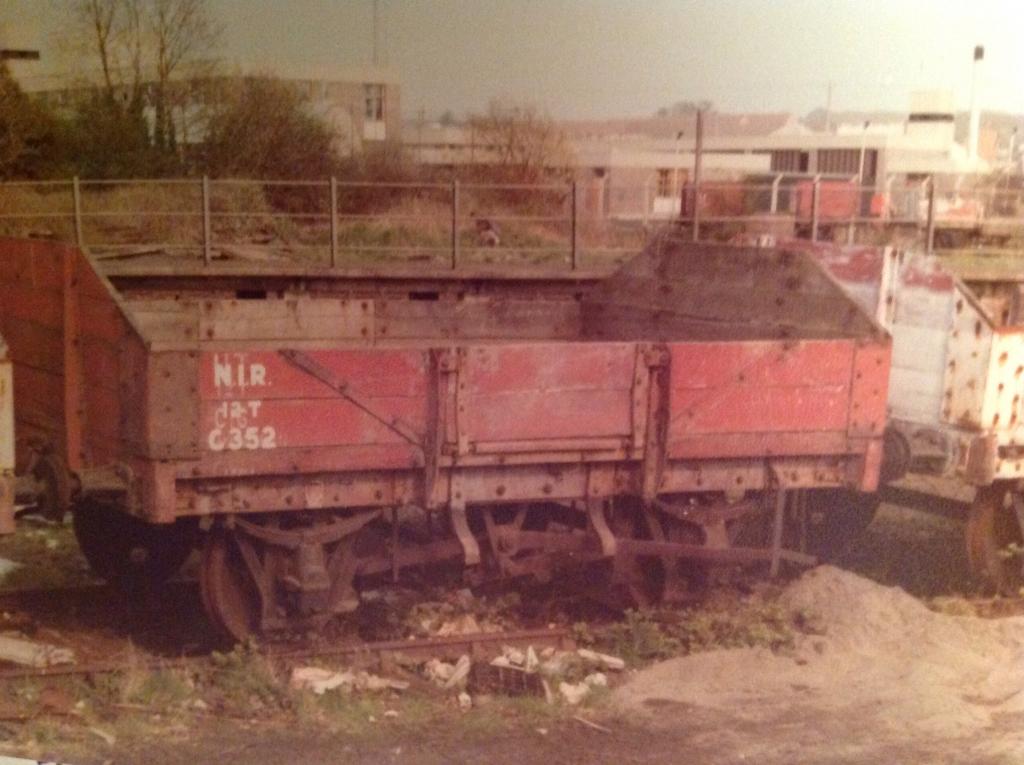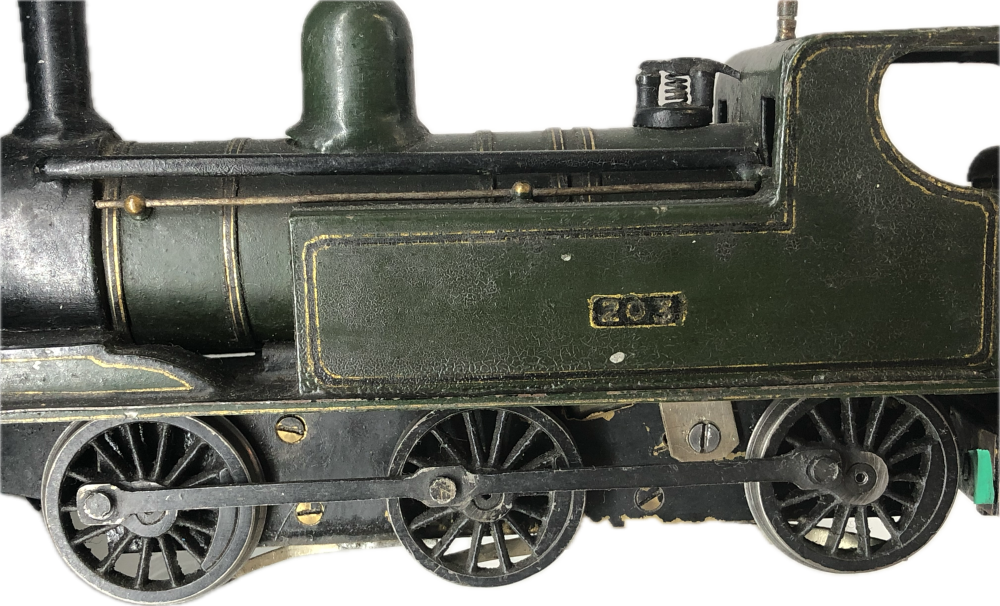-
Posts
15,852 -
Joined
-
Last visited
-
Days Won
393
Content Type
Profiles
Forums
Events
Gallery
Everything posted by jhb171achill
-
Park Royal Update October 2024 - Decorated Samples Revealed!
jhb171achill replied to Warbonnet's topic in News
Having seen them in the flesh at the show……… WOW! Guaranteed winner, and deservedly so, as always with IRM. I’m hoping mine will have authentic cigarette butts on the floor and chewing gum stuck to exactly 12 of its internal seats. Yes, I sat in one once, when a mid-day train to Cork was exceptionally busy and they stuck three on the end of it. I think it was that train, or the same service another day around then, which was the last time I saw a Bredin in traffic…. -
Rails through Northern Parts; the potential
jhb171achill replied to jhb171achill's topic in General Chat
The thing about a shunting layout like that is that it can be anything. Switch to MGWR-livery 0.6.0s and it’s a goods yard in Mayo in 1915. Stick a few “supertrain” livery 071s there, and IRM beet wagons, and it’s somewhere in South Wexford in 1997. If you use ordinary Peco track, the world’s your oyster. Put the right locos and rolling stock on it, and if could literally be almost anywhere in Ireland or Britain, any time from 1890 to the 1990s. It could even pass for a location in certain other countries, maybe. -
A worthy equal!
-
is it just me, or were those things by far the ugliest and most unwieldy looking things ever to take to the rails in Ireland!
-
Despite being a driver, I'd love to see that!
-
Well wrapped consignment of raw materials for Kutch, Hinahan & Co. (Chemical Importers), Dublin & Limerick.
-
The odd coach and loco had it until 1963 or 4 - a handful of vehicles went straight from that to black'n'tan. They had stopped turning anything out fresh in silver after only a few years, 1955-57. By 1958, the last "C" class locos entered service in green. Obviously not everything was repainted overnight, hence the above. Same with the green; while it was superceded in late 1962, there were still a handful of green coaches to be seen as late as 1967. And as I've mentioned before, you'd still see the odd "H" van with a snail on it right to the end of loose-coupled goods in 1976.
-
Tinier loading gauge and narrower track gauge - but - the Dublin United Tramways Co. used to take goods wagons off the Dublin & Blessington Tramway at night, bringing them through the streets hauled by an electric locomotive to the south-side river bank area. This was sand from out beyond a country village called Tallaght....! So nothing's without a precedent. But the Luas would be entirely unsuiatble for Dublin Port traffic, unfortunately. That said, a passenger extension down to the port would facilitate foot passengers on the ferry (all three of them!) and port workers.
-
Just when you thought coaches could not get dearer, or more beautiful
jhb171achill replied to leslie10646's topic in News
This would explain the almost impossibility of finding someone with the skills, willingness and availability to make up brass kits. I’ve a few, but my eyesight and nimbleness aren’t what they were. I wish I’d never bought them……! -
They’d be first generation, as despite not operating since early 1963, a number of steam engines were technically on the books when they were being introduced. It’s reasonable to say they were the last of the first generation, while the 181s were the first of the second generation. Then in the 071s we’ve the only other 2nd gen, and the 201s, I suppose, are the only examples of any 3rd generation? Will there be a 4th? In passenger terms, probably not. Will there be any goods in the future to warrant a 4th gen of freight locos, powered not by diesel but by vegan compliant broccoli juice and zero-emission water?
-
Driver's keys from 121 / 141 / 181s.
-
I hope you spanked them thoroughly....
-
That's what I'd be thinking. If they are, it would be good if the owner donated them, as being proper replicas they would look a lot better. That said, the ones it now carries will in time have their own historic significance as having been cast in Inchicore Works, eighty years after the loco they adorn was built there! Plus, non-standard as they may be, they're the last loco numberplates ever cast in the works. The tradition goes back a century or so, prior to the closure of the foundry. And the raw materials - the brass - came from among the last of the retired first-generation diesels....
-
The lining suggests the livery above, though no clue as to the coach part - probably varnished wood or maroon of some sort.
-
Very true. The originals have to kicking about somewhere - but - beware! The ACTUAL (1915) originals were scrapped when it was last repainted in the very late 1950s, after which, in keeping with CIE policy of the day, it got painted numerals. The plates on it in Fermoy and later Mallow were 1960s replicas, albeit authentically cast by CIE - probably, in fact, the last steam numberplates of standard Inchicore design ever cast. And indeed, as Castleisland Railway "C", it is possible it had no markings at all in its original state. However, having been built at inchicore for the CR, it very probably had the GSWR green livery as shown above from new.
-
That model shown above is actually where the livery for 90 was copied from. It is in the Institute of Mechanical Engineers offices in London, and was built in the 1870s by Inchicore apprentices. As for that no. 60 plate, and Wheeltappers, and genuine Irish railwayana as well as fakes.....well, we all know..... less said about that the better!!
-
Preserved NCC 4.4.0 visited a shed full of Woolwich’s today. A few scenes with a GNR rail car set with post-1958 UTA roundels added…. Meantime, I took a wander round the sidings and goods yard. IMG_0034.mov IMG_0025.mov
- 51 replies
-
- 11
-

-
Based on sage, the herb, this would not be an accurate description. Olive green is distinct, more yellowy-tinted than anything greyish. Thus it would the same base colour as shoiwn on the GSWR model, no more, no less. The only unknown is what shade it was. What little info has survived tends to suggest something similar to the GSR, but on coaches too, though Fry's solitary model of a CBSCR vehicle is a bit lighter. Fry was not infallible, though; while livery accuracy is very meticulours indeed overall, there are a few mdoels which are not correct, for example his GNR "S" class 4.4.0 which is the darker railcar blue rather than the well-known GNR loco blue.
-
That’s the one inaccuracy, unfortunately. The plates were cast out of the last brass buts from scrapped 141s, just as Inchicore’s foundry was closing - but they’re the wrong shape! Livery is correct, though. Number plate background black with green livery, red with GSWR black, and same plain grey as body colour after 1915.
-
To add further to the mix, the day I took this picture at Antrim, there were about half a dozen ballast wagons in that siding. On one at least, there was a metal makers plate, "LMSNCC BUILT 1922". I couldn't get it off. Another wagon had a similar plate which I did take of. These Courtaulds wagons were of bog-standard normal traditional design, so I am assuming they were simply repaints of ordinary (older) traditional opens, no longer needed due to the cessation of goods traffic in the north in 1965? This picture would have been taken about 1977/8/9, I think.
-
Mulling over the latest offerings from IRM, and such items as Provincial Wagons' UTA spoil wagons and other GNR-related stuff, it recalls to mind what potential there is for very individual layout ideas or lines in the North. Small though the system would become after the catastrophic policies of the Stormont government 1950-65, it is a case of small but interesting. Railcar trains with no two vehicles alike, trailing so much goods that they were to all intents and purposes main line mixed trains operated by railcar, a la CDRJC, anyone? Last steam in Ireland, north or south? Modern (brand new 80 class) railcars mixing and mingling with one of the only three Hunslet types ever built, hauling an excursion of de-engined railcars and ancient steam stock, again no two alike..... the lack of goods and lack of mileage is more than made up for with the above matters alone. Go back a little to the 1960s, and we have steam and huge goods traffic on the Derry Road, CIE excursions to Omagh sitting side by side with ex-GNR AEC / BUT railcars. And the wagons. Just like CIE in the fifties had an eclectic mix of brand new goods stock and antique stock from its constituent companies, so the UTA had ex-GNR stuff, ex-NCC and ex-BCDR also. It had the very different designs of NCC goods brake van, among those of GNR origin (like Whitehead's "Ivan", but without those black stripes!), though i don't recall ever seeing any ex-BCDR brake vans. Also the classic GNR Mills architecture (GVS - Dundalk, Newry, & Derry Londonroad), and the very picturesque and unique architecture of the BNCR and later NCC, with the iconic wide-roofed signal cabins and somersault signals. And scenery: Portadown to Finaghy may not inspire - but Castlerock, Downhill, the Warrenpoint branch, much of the Derry Road, and the dramatic coastal scenery of parts of the Larne line? By proportion, even the modern NIR probably has more scenic bits than IE! (N I Tourist Board, please send my payment cheque to the usual offshore account. It would be unfair to burden our tax authorities with even more work). I will be known here for long ago banging on about "when will a Jeep be offered". I sense this may become a more viable issue in times to come - I certainly hope so. Over on RM Web, in between the awful pop-up ads, we see the very excellent Northern Ireland based layouts, not to mention railcar building skills, of the likes of Kirley and others. The interest, like that of CIE, is growing. So what have we - how do we put together a layout based on the UTA / NIR? Let's look at it in two bits. First, pre-65, when you've steam and double the mileage; latterly, the post-1965 times, when the 80 class ruled. 1. UTA At the VERY start we still have the Ballycastle line open, so a layout based on a Ballymoney-style interchange would be interesting. But let's look at stock. Carriages are EASY. Remember the Bachmann set of three "CIE" coaches with a Woolwich? These are standard early 1920s LMS stock in CIE livery In rality, while CIE never posessed a single coach even vaguely similar to these, they are perfect for UTA.The reason is this. We may thank a small Austrian gentleman with a Marx Brothers* moustache who was elected to high office in Germany in 1933, and went on to become famous in the early 1940s. He decided one day to drop bombs on Belfast. In doing so, he obliterated much of the carriages sidings at York Road, and a fair slice of the goods yard. This meant that the still LMS-owned NCC system there had a sudden stock shortage. Large numbers of old secondary, and in some cases withdrawn stock was hurriedly shipped in from England from the parent LMS. All of this was (English) MIdland Railway or LMS origin (no LNWR, funnily enough, as far as I'm aware), and hey presto! Actual LMS designs operating here, the very last of which lasted until the mid 1970s as excursion stock - hauled by none other than IRM's Hunslets. Since the NCC was owned outright by the LMS, their OWN designs built in York Road were built to standard LMS overall house design, albeit with very many local differences - a bit like some of the later Mk 2 BREL types that ran on NIR & CIE being of the same broad dimensions as British equivalents, but door spacings and other things specific to here. Just as in CIE areas, ex-MGWR, ex-GSWR and other stock might be indiscrimately mixed in with their own modern builds, same with UTA. There are Worsley and SSM kits of GNR carriages available, ready to run LMS types, both wooden panelled and steel-sided, which are as near as dammit to what ran on the UTA and later NIR systems. In steam days, we'd still need to botch some sort of Fairburn 2.6.4T; hence my repeated plainmtive wailings for a RTR Jeep. For those lucky enough to have got one, the 00 Works GNR 4.4.0 and 0.6.0 RTR locos are necessary, especially if you're doing the GN section. I remember both types on local trains. Wagons - Leslie's GNR vans - these will be essential. Leslie also does the GNR four wheel passenger van - wodely used for parcels traffic on the GN sections of the UTA. For the NCC the equivalent Brown Van. Model the GN section, and you've a possibility of a newspaper train hauled by steam or a CIE diesel, and with a truly eclectic parade of varied vans behind it: around 1963 it was possible to see, at least in theory, such a train consisting of a new black'n'tan "tin van", andother in green, another in filthy silver, a fitted ex-GN goods van, an ex-GN passenger van in brown and another in UTA green, and as many brown vans as you could shake broiwn van monster at - with perhaps a bogie brake third and a goods brake van. We won't go into fintona trams, but that yoke on the back of a consist like that would hardly raise an eyebrow. While CIE goods stock was very distinct from British designs, and thus an irish layout with simply re-liveried British wagons and vans is really only suitable as a stop-gap measure until Leslie or IRM do a "proper" one, the convenient fact is that while the LMS shipped carriages into belfast in the 1940s rather than large amounts of wagons, the NCC themselves, being LMS-owned, built their own wagons to designs of the same type as the LMS! In several books, or online IRRS photos, the eagle-eyed will spot these "British"-looking designs a mile off. Therefore, certain types of ex-LMS off-the-shelf Hornby / Bachmann / Dapol etc designs will be fine. As with CIE of course, no black chassis; the NCC painted them body colour same as further south. Just as with CIE, there are several MASSIVELY glaring omissions in the RTR - even kit - markets. With CIE, the gaping voids are the lack of the absolutely essential 1950-70 AEC railcars, plus the equally necessary tin vans. I have several JM Design ones - wish i had got more. The Silverfox ones are very crude indeed, and like anything ordered from Silverfox in green, the colour is completely wrong, as is their obsession with light grey roofs. With earlier UTA, it's hardly surprising that none of the railcars like MEDs and MPDs exist - scarcely two of the latter type were alike, and some were converted from 1920s carriages! But if we had the AEC sets, some could be in CIE liveries, of course, but others would be in GNR, UTA and later NIR liveries. But the gaping omissions are Jeeps and the AECs. 2. Late UTA and into NIR days In the late 60s, you've no authentic goods wagons to worry about, as they are all gone. But ballast trains remain. Both in UTA and these later days, Leslie's GNR brake van is key to that. Any old British open wagons can be painted up to look like the old Courtaulds wagons in their unique reddish-brown livery, and the cut down versions hastily slopped over in thin pale grey paint by NIR. (Spare us the black "Ivan" metalwork, though; nothing was ever like this!). You can get away by now without a Jeep, but a couple of filthy ones hauling Leslie's spoil wagons is a great, and unique touch. But as the UTA and CIE have their glaring omissions, the BIGGIE here is the 80 class railcar. Just as iconic as the AECs in the preceding 20 years, or the ICRs in the last 20, a 1980s / 1990s layout based anywhere in the North without 80 class sets simply isn't doable. We can improvise, though. We now have the IRM Hunslet, plus IRM NIR Mk 2 coaches. Soon, it will be possible to have a 1970-early 80s Enterprise. Use a few ex-LMS coaches like the ones with the Woolwich, repainted in NIR's plain maroon, and you've Portrush summer excursions. A change for your maroon Hunslet to haul. We need the 80, but if you're post-1986, if you can get one there's the blue NIR 111, IRM Mk 2s in appropriate livery, and those yellow bopgie ballast wagons. But there are British railcars with sliding doors in 2 or 3 car sets - don't ask me what class - too modern to be of any interest to me - which look near enough like the "Castle" (or 450) class railcars of NIR. Naturally, if modelling the GNR main line, we've the Dundalk goods. Enter, stage left, IRM's "H" vans, Leslies' also, and Leslie's GNR brake vans, JM Design's excellent-looking CIE brake vans - another essential on an all-Ireland basis, of course, the SSM kit of same; and for the later period IRM's bubbles, Guinness, ferts and container flats. And of course we have the 121s and 141s and A class of Messrs Murphy / IRM. None existed as the UTA was formed, so every livery that each of these appears in is appropriate to at least some period in the existence of UTA & NIR. I am hearing noises about growing interest in pre-CIE in the south - will we see GSR carriages some day? It is not long ago that the idea of the grey'n'green era on CIE would have been considered a step too far for the commerical market, but IRM's silver and green "A"'s changed all that. Hatton's ex-GSWR six-wheelers helped, as did JM Design's and Provincial Wagons' earlier designs of brake vans. I am a great believer that if a small number of very high quality RTR models of something appear, there's a very good chance interest will follow. IRM started by producing Mk 2 coaches. Murphy Models' 111 (which, according to Paddy Murphy at the show the other week, is due a re-run) and his 121s and 141s were a ground breaker too. Now we've Hunslets, and 1990s-type NIR ballast wagons can be had commercially and repainted, as they were BR imports of ex-Southern Railway origin, with a nickname of a shark, antelope, mollusc, or tree-eating skunk, as per BR nomenclature. We have Cravens, and a BR GSV van can be had or repainted from a BR Mk 1, so we've the Enterprise (bar its dining car). So we already have the beginnings of northern-based locos and rolling stock. Hopefully a new extension of our interest range into earlier times (GSR) and northern climes (UTA / NIR) will develop. This will leave, as the only voids in the RTR world, the GNR and BCDR. But those are for another day. I sense that such evolution is already beginning to take place. I hope so. Meantime, we may hope for 80 class and AEC railcars, tin vans and laminates.... and a Jeep and a RTR GNR loco. (* Those youngsters born from 1970 onwards, look them up!)
- 21 replies
-
- 10
-

-
In reality, if you take any batch of any type of wagon ever built here (or for here in this 9rare) case), you will find that after not too long a time, at the very least lettering styles, positions of wagons numbers, location of logos or lettering, and even fonts used, can vary significantly. These hoppers were very short-lived by wagon standards - very short-lived indeed, and limited in where they went. They never saw Newry, Omagh or Enniskillen, let alone West Cork. Compare with batches of, say, goods vans, built in 1890 by one of the bigger companies such as the GSW, examples of which were still to be seen bumbling around the place seventy or eighty years later - think of the potential there for "no two alike"; and we're still only talking of livery! Add to that differing wheels over the years, differing buffers, changes to the side strapping, non-standard doors, different ends after some sort of reconstruction, and so on. Wagons weren't seen as being as "glamorous" as carriages, so often there could be hastily improvised alterations. Going back to liveries, back in the day care would be taken to adhere to the company livery policy if a coach was altered, repainted or rebuilt - but that wasn't seen as being so important with wagons, which were basically workaday Amazon Prime boxes on wheels.
-
Someone, somewhere, recently asked me about this. The answer lies in this (Cyril Fry) model, and / or the (correct) livery currently carried by 90 at Downpatrick. Fry’s model carried one of two lining styles used approx 1880-1902, whereas 90 has the earlier style. Same green, though. The pale green seen at the 1996 open day at Inchicore was entirely incorrect for any era, as were the shade on 90 when in Mallow, and on 184 in its last years in CIE use. It is likely that this isn’t a million miles off what the CBSCR used, though further research on that is necessary.
-
I dream of Achill….
.png.c363cdf5c3fb7955cd92a55eb6dbbae0.png)



